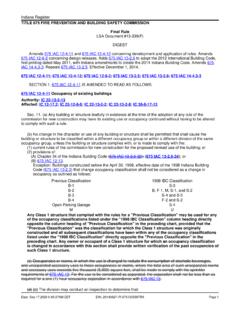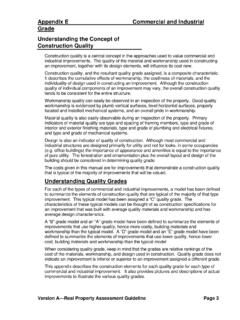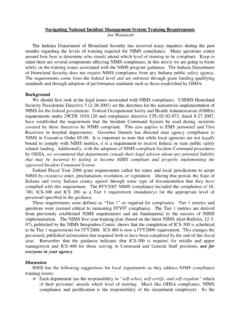Transcription of INDOT 2021 - IN.gov
1 INDOT STIP 2018 -2021 This is INDOT STIP document for the Fiscal Year 2018 -2021. INDOT STIP TABLE OF CONTENTS Introduction Page 1 Public Involvement Process Page 4 Annual Program Development Process Page 7 Performance-Based Planning and Asset Management Page 10 Requirements for STIP Amendments and Administrative Page 15 Modifications Metropolitan Area Transportation Improvement Program (TIPs) Page 16 Air Quality Page 17 Environmental Justice Page 19 Accessibility/ADA Page 21 Funding Programs Page 23 Financial Discussion, Tables and Summary Appendix A How to Read the FHWA Project Listing Appendix B Project Listing Appendix C Transit Project Listing Appendix D Amendment Procedures Appendix E Asset Management Capital Program Management Appendix F Louisville-Sothern indiana Ohio River Bridges Projects Appendix G Interstate 69, Section 5 Appendix H Interstate 69, Section 6 Appendix i Media Release Appendix J Public Comments Appendix K 2018 -2021 INDOT State Transportation Improvement Program Page 1 INTRODUCTION The Statewide Transportation Improvement Program (STIP) is a key document in the Federal transportation planning and programming process.
2 States are required to develop STIPs covering at least four years of federally-funded surface transportation projects in consultation with Metropolitan Planning Organizations (MPOs), Tribal governments, and local governments in nonmetropolitan areas, and with the participation of the public and interested parties. Projects contained in the STIP must be consistent with the statewide transportation plan, identical to project phases in approved metropolitan transportation improvement programs and consistent with approved metropolitan transportation plans, and must be in conformance with applicable State air quality implementation plans. STIPs must demonstrate fiscal-constraint and may include a financial plan, including project phases which the State reasonably expects can be fully funded within the specified time period, and illustrative projects that would be included if additional resources become available. States are required to update the STIP at least once every four years and the STIP and any amendments must be approved by Federal Highway Administration (FHWA) and Federal Transit Administration (FTA).
3 indiana s STIP is four-year fiscally constrained planning document (see Appendix A) that lists all projects expected to be Federally funded in years 2018 , 2019, 2020, and 2021, as well as State funded projects that have been deemed regionally significant (see Appendix B, Appendix C, and Appendix D). Regionally significant projects add capacity to roadways, are on a facility which serves regional transportation needs, and would normally be included in the modeling of the metropolitan area s transportation network. At a minimum, this includes all principal arterial highways and all fixed guideway transit facilities that offer a significant alternative to regional highway travel. The STIP includes investments in various modes, such as transit, highways, and bicycle facilities, and is the means of implementing the goals and objectives identified in State and Metropolitan Long-Range Transportation Plans and are consistent with the required planning factors in 23 USC 135(d).
4 Only those projects for which construction and operating funds can reasonably be expected to be available are included; however, it is updated on a two-year cycle. Developing and maintaining a STIP serves as a means for effective transportation planning across several key areas, including the following identified by FHWA: Increasing public transparency of the use of Federal funds for transportation projects by compiling all Federally-supported projects in one document Ensuring appropriate consultation among transportation planning partners in each State so that Tribal, local, and regional priorities are considered Reflecting the multimodal nature of the Federal surface transportation program and a focus on multimodal system efficiency by including projects across all modes of surface transportation Supporting sound financial planning by requiring that the projected costs of included projects are consistent with funds reasonably expected to be available to implement them Improving the efficiency of oversight of the use of Federal funds for transportation by requiring that all Federally-supported projects be listed in the approved STIP 2018 -2021 INDOT State Transportation Improvement Program Page 2 The STIP is a collaborative effort of several statewide planning partners.
5 So, who are they? MPOs = Metropolitan Planning Organizations. They serve transportation planning needs in large urban areas, technically, metropolitan planning areas which the Census identifies as having over 50,000 in population, and defines as an Urbanized Areas plus the surrounding area expected to become urban in the next 20 years. indiana has 14 MPOs! Each one creates its own TIP, or, Transportation Improvement Program, which is a 4-year planning program, similar to the STIP, but only contains projects in their area. RPOs = Regional Planning Organizations. They are responsible for economic development planning and conduct transportation planning as part of INDOT s Small Urban and Rural Transportation Planning Assistance Program. They also serve as MPOs in some areas. indiana has 12 RPOs! Click here for an interactive map and contact information for indiana MPOs 2018 -2021 INDOT State Transportation Improvement Program Page 2 The STIP includes projects from all 14 individual TIPs, which feed directly into the document, in addition to all projects outside of those designated areas.
6 Without inclusion in an approved TIP and STIP, a project is not eligible for federal funding. There is a limited supply of funds that INDOT receives from the Federal Government to program in the STIP; therefore, programming those funds requires maintaining a balance between needs and priorities, project eligibility determinations, project readiness and timing, and funding availability. The STIP must demonstrate conformity to Federal guidelines and regulations set out in the current transportation bill and be approved by FHWA and FTA in order for indiana to receive funding. Federal regulations related to the STIP apply equally to all 50 states and do not take into account individual states sizes, legislative processes or budget cycles. For a brief history on the metropolitan planning process that is adhered to by states and local governments and leads to the creation of planning documents such as the STIP, we must look back to the foundation of urban transportation planning in the early 1960 s.
7 With the Federal Aid Highway Act of 1962, it was federally mandated, as a condition for receiving Federal financial aid, that planning for transportation projects in urbanized areas of 50,000 or more as defined by the Census be based on a continuing, comprehensive and cooperative planning process. This is now commonly referred to as the 3C Process, and is still the foundation of transportation planning, leading to a cohesive planning effort on behalf of state and local governments, and resulting in the creation of MPOs and RPOs. Moving forward to today, the 3C process as a framework for making transportation investment decisions in metropolitan areas is continued through the transportation legislation FAST Act. Access the USDOT Fact Sheet on Metropolitan Planning under FAST Act here The indiana Department of Transportation ( INDOT ), Office of Technical Planning and Office of Local Planning Agency ( LPA) and Grant Administration, develops the STIP in cooperation with the MPOs and in consultation with the Rural Planning Organizations (RPOs) and Non-Metropolitan local officials.
8 INDOT reviews and approves the MPO s TIPs for incorporation into the STIP via reference. This comprehensive process follows the 3C components of transportation planning. The STIP is developed in accordance with the terms and provisions of the Federal Highway funding bill Fixing America Surface Transportation (FAST) Act. According to these regulations, a STIP: must be developed once every four years; must cover a minimum of four years; must list projects in order by year; must be financially constrained by year; o 5. must include a financial plan that demonstrates listed projects can be implemented using current and anticipated revenue sources; must include all regionally significant projects that could affect air quality; must come from conforming State and Metropolitan Long Range Transportation Plans; o 8. must be found to meet air quality conformity requirements found within the State Implementation Plan (SIP); and o 9. individual project entries must contain the following information: Learn more history about MPOs, RPO s and the early evolution of urban transportation planning from AMPO.
9 2018 -2021 INDOT State Transportation Improvement Program Page 3 o project description, including sufficient detail to identify the project phase and, in nonattainment or maintenance areas, sufficient description to permit air quality analysis according to the Environmental Protection Agency's (EPA) conformity regulations. o specific project budget, including, total cost, Federal share and source by year, other funding shares and sources by year and o identification of agencies responsible for carrying out the project of phase. This STIP is intended to satisfy the requirements of 23 Sections 134 and 135 and their implementing regulations 23 CFR 450 and 49 CFR 613. This STIP has been prepared in accordance with joint FHWA/FTA regulations (23 CFR Part 450 and 49 CFR Part 613) accounting for related statutory changes in Public Law 112-141 Moving Ahead for Progress in the 21st Century Act, along with Public Law 114-357 Fixing America s Surface Transportation Act (FAST Act) enacted on December 4, 2015.
10 This overall multi-modal STIP reflects INDOTs currently approved state and local programs within the limits of apportioned federal aid. All projects in the 2017-2020 timeframe are affordable and selected for implementation. Any subsequent changes in the project listing involving the addition or deletion of projects or significant changes in project schedule or estimated cost will be processed in accordance with the STIP amendment process outlined herein prior to requesting obligation of funds. 2018 -2021 INDOT State Transportation Improvement Program Page 4 PUBLIC I NVOLVEMENT PROCESS Including the public in the transportation planning process is not only a requirement for a sound, transparent planning process, it is also a Federal requirement for projects funded with FHWA and FTA dollars. Public involvement and citizen engagement in the planning process for the STIP occurs at various levels, as each MPO/RPO solicits public involvement on their respective projects per each MPO Public Participation Plan.















